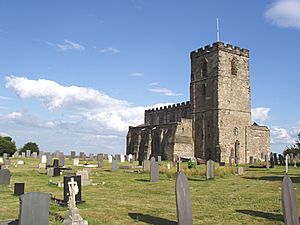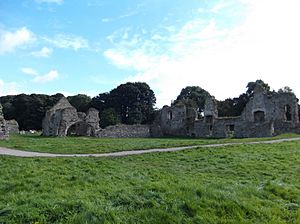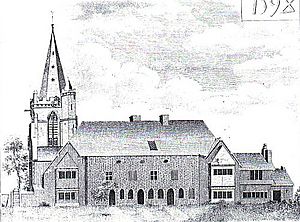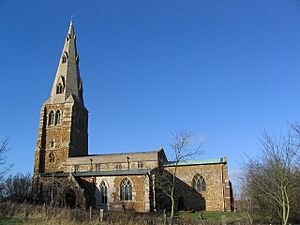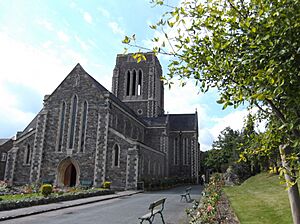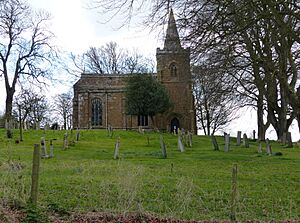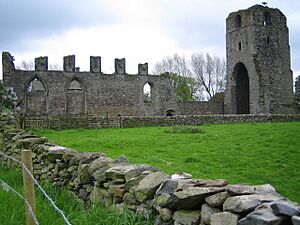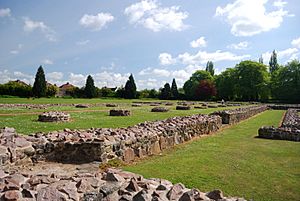List of monastic houses in Leicestershire facts for kids
Imagine a time long ago when people dedicated their lives to prayer, study, and helping others, living together in special communities. These places were called monastic houses. In Leicestershire, England, there were many such houses, including abbeys, priories, and friaries.
- Monks and nuns lived in abbeys and priories. They followed strict rules and spent their days in prayer, work, and study.
- Friars were similar but often lived in towns and went out to preach and help people.
- A preceptory was a base for military-religious orders like the Knights Templar or Knights Hospitaller.
Most of these houses were closed down in the 1530s by King Henry VIII during an event called the Dissolution of the Monasteries. Today, only ruins or new buildings remain at many of these historic sites.
Contents
Ancient Monastic Sites
Some of the earliest monastic sites in Leicestershire date back to Anglo-Saxon times.
Holy Hill Monastery, Breedon
This was likely the oldest monastic site in Leicestershire. It was founded in the late 600s by Benedictine monks from Peterborough. Sadly, it was abandoned around 874 during raids by the Vikings.
Breedon Priory
Later, between 1109 and 1122, an Augustinian Priory was built on the same site. It was called Breedon Priory. The church of Saints Mary and Hardulph was given to Nostell Priory in Yorkshire. This priory was closed in 1539.
Priories and Abbeys
Many different types of monastic houses existed across Leicestershire.
Belvoir Priory
Belvoir Priory was a home for Benedictine monks. It was founded between 1076 and 1088 by Robert de Todeni, the lord of Belvoir. This priory was a "cell," meaning it was a smaller house dependent on the much larger St Albans Abbey in Hertfordshire. It was closed in 1539.
Croxton Abbey
Croxton Abbey was founded before 1160 by William Porcarius. It was home to Premonstratensian Canons, who were a type of religious order. The abbey was closed in 1538. Today, only ruins remain.
Garendon Abbey
This abbey was founded on October 28, 1133, by Robert Bossu, the Earl of Leicester. It was home to Cistercian monks. Garendon Abbey was likely a "daughter house" of Waverley Abbey in Surrey. It was closed in 1536. A house called 'Garendon Hall' was later built on the site, but it was demolished in 1964.
Grace Dieu Priory
Grace Dieu Priory was founded around 1239 or 1240 by Rose de Verdon. It was home to Augustinian Canonesses, also known as the 'White Nuns of St Augustine'. The priory was closed in 1538. Today, some remains are part of a cottage, and the site is open to the public.
Hinckley Priory
Hinckley Priory was an "alien house," meaning it was a cell dependent on a monastery in another country, Lyre in France. It was home to Benedictine monks and was founded before 1173. The priory was closed in 1409. Later, a mansion and then private houses were built on the site.
Kirby Bellars Priory
This priory started as a college or chantry in 1316. It later became home to Augustinian Canons Regular in 1359. After a fire around 1511, the buildings were rebuilt. The priory was closed in 1536. Today, you can still see earthworks that mark the site in a field north of the local church.
Langley Priory
Langley Priory was founded around 1150 by William Pantulf and his wife. It was home to Benedictine nuns. For a time, it was thought to be a Cistercian nunnery, but this claim was dropped. The priory was closed in 1536. Parts of the medieval building are still part of a house today.
Launde Priory
Launde Priory was founded between 1119 and 1125 by Richard Basset and his wife Maud. It housed Augustinian Canons Regular. The priory was closed in 1539. Today, the site is home to a manor house called 'Launde Abbey', which is now a retreat and conference centre.
Mount St Bernard Abbey
This is a unique case because it's still active! The first Mount St Bernard Abbey was founded in 1835 by Cistercian monks (also known as Trappists). A new, larger monastery was built in 1844, and the original site became a guest house. The new abbey is still active today, with monks living there.
Owston Abbey
Owston Abbey was founded before 1161 by Sir Robert Grimbald. It was home to Augustinian Canons Regular. The abbey was closed in 1536. The site is now private property, known as Manor Farm, but the church has been restored and is still used by the local community.
Ulverscroft Priory
Ulverscroft Priory was founded before 1174 by Robert, Earl of Leicester. It was home to Augustinian Canons Regular. Although many monasteries were closed in 1536, Ulverscroft managed to avoid this for a few years. It was finally closed on September 15, 1539. The site is now privately owned.
Monastic Houses in Leicester
The city of Leicester itself was home to several important monastic communities.
Leicester Abbey
Leicester Abbey was founded in 1143 by Robert Bossu, the Earl of Leicester. It housed Augustinian Canons Regular. The abbey was a very important religious centre in the region. It was closed in 1538. Its formal name was "The Abbey Church of the Assumption of the Blessed Virgin Mary."
Leicester Friaries
Leicester had several friaries, which were homes for different orders of friars:
- Austin Friars: These Augustinian hermits founded their house in 1254. It was closed in November 1538.
- Blackfriars: These were Dominican Friars, founded before 1284. Their house was closed in 1538.
- Greyfriars: These were Franciscan Friars Minor, founded before 1230. This friary is famous as the burial place of King Richard III after he died at the Battle of Bosworth Field in 1485. His body was found there in 2013! The friary was closed in 1538.
- Holy Cross Priory: This is a modern Dominican Friary founded in 1882. Its church was consecrated in 1958, and it is still active today.
- Friars of the Sack: This was a smaller order of friars, founded before 1274. Their house was abandoned by 1295.
Preceptories
Preceptories were bases for military-religious orders.
Dalby and Heather Preceptory
This preceptory was home to the Knights Hospitallers, a famous military-religious order. It was founded before 1206. The preceptory was closed in 1538.
Rothley Temple
Rothley Temple was first home to the Knights Templar, another famous military order, founded in 1231. Their chapel was built around 1240. Later, in 1312, the property was transferred to the Knights Hospitaller. It was eventually taken over by the Crown. A manor house was later built on the site.
Swinford Preceptory
This preceptory was also for the Knights Hospitaller, founded before 1199. It was managed under the Dalby preceptory for a time. It was closed in 1538.
Images for kids
See also


